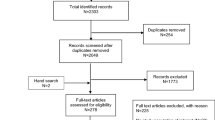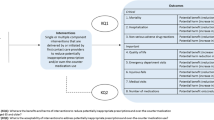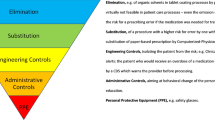Abstract
Inappropriate prescribing of medicines may lead to a significant risk of an adverse drug-related event. In particular, prescribing may be regarded as inappropriate when alternative therapy that is either more effective or associated with a lower risk exists to treat the same condition. This review aims to identify interventions and strategies that can significantly reduce inappropriate prescribing in the elderly. The review is based on a search of electronic databases using synonyms of keywords such as ‘elderly’, ‘interventions’, ‘optimized prescribing’ and ‘inappropriate prescribing’ to identify reported interventions intended to improve inappropriate prescribing in the elderly. A total of 711 articles published in English were retrieved and considered. Of these, 24 original studies, involving 56 to 124802 participants, met the inclusion criteria and were included in the systematic review. In 16 studies, the statistical power used to assess the impact of the intervention was >90% at a significance level of α=0.05.
Various interventions were included in this study, such as educational interventions, medication reviews, geriatricians’ services, multidisciplinary teams, computerized support systems, regulatory policies and multi-faceted approaches. Because of variability in assessment methodologies, mixed responses were found for education interventions aimed at improving inappropriate prescribing. For example, some studies did not assess what data were required to define whether a given level of intervention would be adequate, and others did not consider how many participants would be needed to demonstrate that a significant difference existed.
Each of the three computerized support system interventions reported produced a significant enhancement in both prescribing and dispensing practices. Pharmacist interventions in community and hospital settings were evaluated in seven studies. However, variable criteria were used, with two studies using the Medication Appropriateness Index, another two studies using self-designed criteria for inappropriate prescribing, and the remaining three studies using Beers’ criteria. A difficulty in assessing studies involving nursing home residents is that both consultant pharmacists and onsite pharmacist services may be involved, and, in one of the studies, only the role of the consultant pharmacist was considered. One of the most effective interventions appeared to be multidisciplinary case conferences involving a geriatrician, which resulted in a number of examples of reduced inappropriate prescribing in both community and hospital settings. As the effect of regulatory policies as an intervention is dependent on the target population involved, the effectiveness of this type of intervention was variable.
Different strategies may be useful in reducing inappropriate prescribing in the elderly. It is not clear whether combined strategies undertaken simultaneously have a synergistic effect.









Similar content being viewed by others
Notes
In 1996, the US Medical Expenditure Panel survey divided 33 medications from Beers’ criteria into ‘always inappropriate’, ‘rarely appropriate’ and ‘appropriate for some indications’.
References
Gallagher P, Barry P, O’Mahony D. Inappropriate prescribing in the elderly. J Clin Pharm Ther 2007 Apr; 32(2): 113–21
Roberts MS, Stokes JA, King MA, et al. Outcomes of a randomized controlled trial of a clinical pharmacy intervention in 52 nursing homes. Br J Clin Pharmacol 2001 Mar; 51(3): 257–65
Sorensen L, Stokes JA, Purdie DM, et al. Medication reviews in the community: results of a randomized, controlled effectiveness trial. Br J Clin Pharmacol 2004 Dec; 58(6): 648–64
Moore TJ, Cohen MR, Furberg CD. Serious adverse drug events reported to the Food and Drug Administration, 1998–2005. Arch Intern Med 2007 Sep 10; 167(16): 1752–9
Lindley CM, Tully MP, Paramsothy V, et al. Inappropriate medication is a major cause of adverse drug reactions in elderly patients. Age Ageing 1992 Jul; 21(4): 294–300
Pillans PI, Roberts MS. Overprescribing: have we made any progress? Aust N Z J Med 1999 Aug; 29(4): 485–6
Beers MH, Ouslander JG, Rollingher I, et al. Explicit criteria for determining inappropriate medication use in nursing home residents. UCLA Division of Geriatric Medicine. Arch Intern Med 1991 Sep; 151(9): 1825–32
Naugler CT, Brymer C, Stolee P, et al. Development and validation of an improving prescribing in the elderly tool. Can J Clin Pharmacol 2000 Summer; 7(2): 103–7
Hanlon JT, Schmader KE, Samsa GP, et al. A method for assessing drug therapy appropriateness. J Clin Epidemiol 1992 Oct; 45(10): 1045–51
O’Mahony D, Gallagher PF. Inappropriate prescribing in the older population: need for new criteria. Age Ageing 2008 Mar; 37(2): 138–41
Beers MH. Explicit criteria for determining potentially inappropriate medication use by the elderly: an update. Arch Intern Med 1997 Jul 28; 157(14): 1531–6
Fick DM, Cooper JW, Wade WE, et al. Updating the Beers criteria for potentially inappropriate medication use in older adults: results of a US consensus panel of experts. Arch Intern Med 2003 Dec 8–22; 163(22): 2716–24
Barry PJ, O’Keefe N, O’Connor KA, et al. Inappropriate prescribing in the elderly: a comparison of the Beers criteria and the improved prescribing in the elderly tool (IPET) in acutely ill elderly hospitalized patients. J Clin Pharm Ther 2006 Dec; 31(6): 617–26
Stuck AE, Beers MH, Steiner A, et al. Inappropriate medication use in community-residing older persons. Arch Intern Med 1994 Oct 10; 154(19): 2195–200
Brekke M, Rognstad S, Straand J, et al. Pharmacologically inappropriate prescriptions for elderly patients in general practice: how common? Baseline data from the Prescription Peer Academic Detailing (Rx-PAD) study. Scand J Prim Health Care 2008 Jun; 26(2): 80–5
King MA, Roberts MS. The influence of the Pharmaceutical Benefits Scheme (PBS) on inappropriate prescribing in Australian nursing homes. Pharm World Sci 2007 Feb; 29(1): 39–42
Zhan C, Sangl J, Bierman AS, et al. Potentially inappropriate medication use in the community-dwelling elderly: findings from the 1996 Medical Expenditure Panel Survey. JAMA 2001 Dec 12; 286(22): 2823–9
Beers MH, Ouslander JG, Fingold SF, et al. Inappropriate medication prescribing in skilled-nursing facilities. Ann Intern Med 1992 Oct 15; 117(8): 684–9
Fialova D, Topinkova E, Gambassi G, et al. Potentially inappropriate medication use among elderly home care patients in Europe. JAMA 2005 Mar 16; 293(11): 1348–58
Goodman M, Lazzarini R. Examination of the feasibility of an ongoing strategy for disposal of unwanted and outdated medicines [abstract]. The Pharmaceutical Education Program 1995 Work in Progress Conference; 1995 Aug 24–26; Sydney (NSW)
Blackbourn J. Readmission to Fremantle Hospital: part 2. Drug-related readmissions. Fremantle Hosp Drug Bull 1991; 15: 13–6
Dartnell JG, Anderson RP, Chohan V, et al. Hospitalisation for adverse events related to drug therapy: incidence, avoidability and costs. Med J Aust 1996 Jun 3; 164(11): 659–62
Roberts MS, Stokes JA. Prescriptions, practitioners and pharmacists. Med J Aust 1998 Apr 6; 168(7): 317–8
Garcia RM. Five ways you can reduce inappropriate prescribing in the elderly: a systematic review. J Fam Pract 2006 Apr; 55(4): 305–12
Bell S, McLachlan AJ, Aslani P, et al. Community pharmacy services to optimise the use of medications for mental illness: a systematic review. Aust N Z Health Policy 2005; 2: 29
Cribb A, Barber N. Prescribers, patients and policy: the limits of technique. Health Care Anal 1997 Dec; 5(4): 292–8
Allard J, Hebert R, Rioux M, et al. Efficacy of a clinical medication review on the number of potentially inappropriate prescriptions prescribed for community-dwelling elderly people. CMAJ 2001 May 1; 164(9): 1291–6
Batuwitage BT, Kingham JG, Morgan NE, et al. Inappropriate prescribing of proton pump inhibitors in primary care. Postgrad Med J 2007 Jan; 83(975): 66–8
Hanlon JT, Weinberger M, Samsa GP, et al. A randomized, controlled trial of a clinical pharmacist intervention to improve inappropriate prescribing in elderly outpatients with polypharmacy. Am J Med 1996 Apr; 100(4): 428–37
Monane M, Matthias DM, Nagle BA, et al. Improving prescribing patterns for the elderly through an online drug utilization review intervention: a system linking the physician, pharmacist, and computer. JAMA 1998 Oct 14; 280(14): 1249–52
Pimlott NJ, Hux JE, Wilson LM, et al. Educating physicians to reduce benzodiazepine use by elderly patients: a randomized controlled trial. CMAJ 2003 Apr 1; 168(7): 835–9
Raebel MA, Charles J, Dugan J, et al. Randomized trial to improve prescribing safety in ambulatory elderly patients. J Am Geriatr Soc 2007 Jul; 55(7): 977–85
Rahme E, Choquette D, Beaulieu M, et al. Impact of a general practitioner educational intervention on osteoarthritis treatment in an elderly population. Am J Med 2005 Nov; 118(11): 1262–70
Simon SR, Smith DH, Feldstein AC, et al. Computerized prescribing alerts and group academic detailing to reduce the use of potentially inappropriate medications in older people. J Am Geriatr Soc 2006 Jun; 54(6): 963–8
Tamblyn R, Huang A, Perreault R, et al. The medical office of the 21st century (MOXXI): effectiveness of computerized decision-making support in reducing inappropriate prescribing in primary care. CMAJ 2003 Sep 16; 169(6): 549–56
Wessell AM, Nietert PJ, Jenkins RG, et al. Inappropriate medication use in the elderly: results from a quality improvement project in 99 primary care practices. Am J Geriatr Pharmacother 2008 Mar; 6(1): 21–7
Briesacher B, Limcangco R, Simoni-Wastila L, et al. Evaluation of nationally mandated drug use reviews to improve patient safety in nursing homes: a natural experiment. J Am Geriatr Soc 2005 Jun; 53(6): 991–6
Crotty M, Halbert J, Rowett D, et al. An outreach geriatric medication advisory service in residential aged care: a randomised controlled trial of case conferencing. Age Ageing 2004 Nov; 33(6): 612–7
Lau DT, Kasper JD, Potter DE, et al. Potentially inappropriate medication prescriptions among elderly nursing home residents: their scope and associated resident and facility characteristics. Health Serv Res 2004 Oct; 39(5): 1257–76
Rhoads M, Thai A. Physician acceptance rate of pharmacist recommendations to reduce use of potentially inappropriate medications in the assisted living setting. Consult Pharm 2003 Mar; 18(3): 241–7
Saltvedt I, Spigset O, Ruths S, et al. Patterns of drug prescription in a geriatric evaluation and management unit as compared with the general medical wards: a randomised study. Eur J Clin Pharmacol 2005 Dec; 61(12): 921–8
Spinewine A, Swine C, Dhillon S, et al. Effect of a collaborative approach on the quality of prescribing for geriatric inpatients: a randomized, controlled trial. J Am Geriatr Soc 2007 May; 55(5): 658–65
Elliott RA, Woodward MC, Oborne CA. Improving benzodiazepine prescribing for elderly hospital inpatients using audit and multidisciplinary feedback. Intern Med J 2001 Dec; 31(9): 529–35
Brown BK, Earnhart J. Pharmacists and their effectiveness in ensuring the appropriateness of the chronic medication regimens of geriatric inpatients. Consult Pharm 2004 May; 19(5): 432–6
Krska J, Cromarty JA, Arris F, et al. Pharmacist-led medication review in patients over 65: a randomized, controlled trial in primary care. Age Ageing 2001 May; 30(3): 205–11
Lipton HL, Bero LA, Bird JA, et al. The impact of clinical pharmacists’ consultations on physicians’ geriatric drug prescribing: a randomized controlled trial. Med Care 1992 Jul; 30(7): 646–58
Lane CJ, Bronskill SE, Sykora K, et al. Potentially inappropriate prescribing in Ontario community-dwelling older adults and nursing home residents. J Am Geriatr Soc 2004 Jun; 52(6): 861–6
Crotty M, Rowett D, Spurling L, et al. Does the addition of a pharmacist transition coordinator improve evidence-based medication management and health outcomes in older adults moving from the hospital to a long-term care facility? Results of a randomized, controlled trial. Am J Geriatr Pharmacother 2004 Dec; 2(4): 257–64
Schmader KE, Hanlon JT, Pieper CF, et al. Effects of geriatric evaluation and management on adverse drug reactions and suboptimal prescribing in the frail elderly. Am J Med 2004 Mar 15; 116(6): 394–401
Hawkey CJ, Hodgson S, Norman A, et al. Effect of reactive pharmacy intervention on quality of hospital prescribing. BMJ 1990 Apr 14; 300(6730): 986–90
Smith DH, Perrin N, Feldstein A, et al. The impact of prescribing safety alerts for elderly persons in an electronic medical record: an interrupted time series evaluation. Arch Intern Med 2006 May 22; 166(10): 1098–104
Spinewine A, Schmader KE, Barber N, et al. Appropriate prescribing in elderly people: how well can it be measured and optimised? Lancet 2007 Jul 14; 370(9582): 173–84
Tinetti ME, Bogardus Jr ST, Agostini JV, et al. Potential pitfalls of disease-specific guidelines for patients with multiple conditions. N Engl J Med 2004 Dec 30; 351(27): 2870–4
Hux JE, Melady MP, DeBoer D. Confidential prescriber feedback and education to improve antibiotic use in primary care: a controlled trial. CMAJ 1999 Aug 24; 161(4): 388–92
Gallagher PF, Barry PJ, Ryan C, et al. Inappropriate prescribing in an acutely ill population of elderly patients as determined by Beers’ criteria. Age Ageing 2008 Jan; 37(1): 96–101
Sorensen L, King MA, Ientile CS, et al. Has drug therapy gone to the dogs? Age Ageing 2003 Jul; 32(4): 460–1
Sorensen L, Stokes JA, Purdie DM, et al. Medication management at home: medication-related risk factors associated with poor health outcomes. Age Ageing 2005 Nov; 34(6): 626–32
Sorensen L, Stokes JA, Purdie DM, et al. Medication management at home: medication risk factor prevalence and inter-relationships. J Clin Pharm Ther 2006 Oct; 31(5): 485–91
Lentile CS, Sorensen L, Lemanski L, et al. Complementary medicines use by Australian veterans. J Pharm Pract Res 2005; 35(2): 110–1
Acknowledgements
No sources of funding were used to assist in the preparation of this review. The authors have no conflicts of interest that are directly relevant to the content of this review.
Author information
Authors and Affiliations
Corresponding author
Rights and permissions
About this article
Cite this article
Kaur, S., Mitchell, G., Vitetta, L. et al. Interventions that can Reduce Inappropriate Prescribing in the Elderly. Drugs Aging 26, 1013–1028 (2009). https://doi.org/10.2165/11318890-000000000-00000
Published:
Issue Date:
DOI: https://doi.org/10.2165/11318890-000000000-00000




